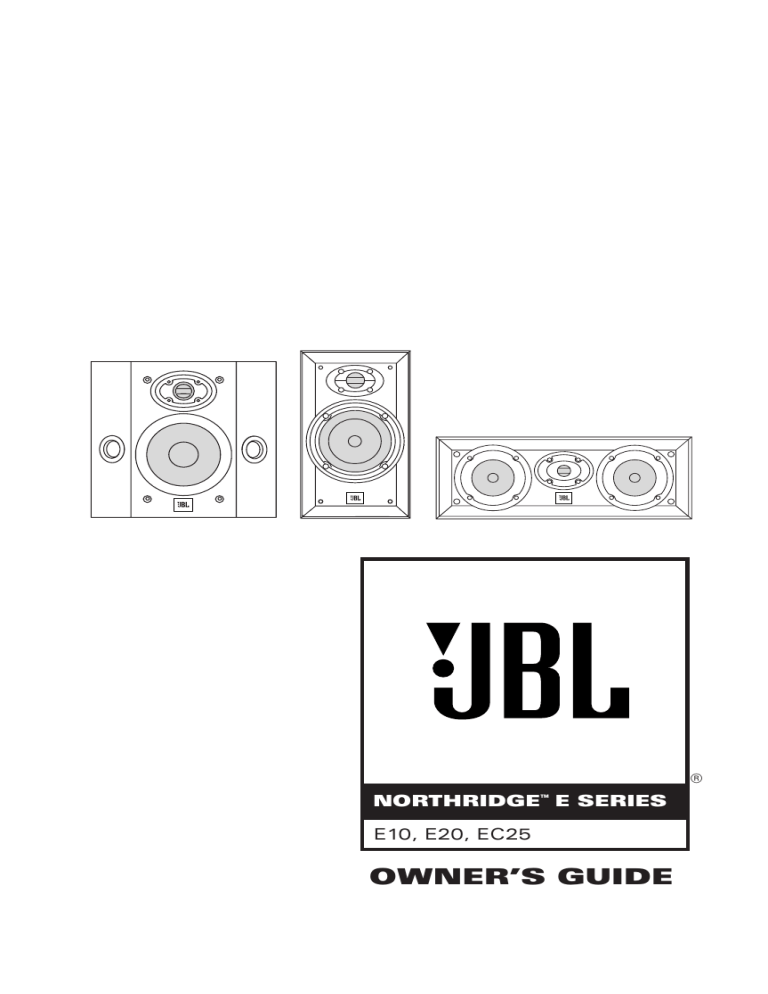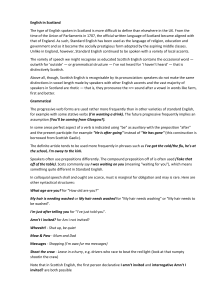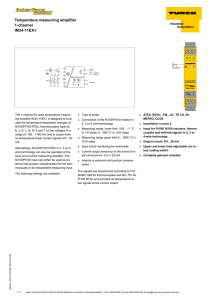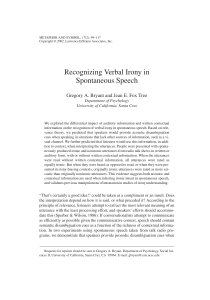
® NORTHRIDGE™ E SERIES E10, E20, EC25 OWNER’S GUIDE SPEAKER PLACEMENT Proper placement of the speakers is an important step in obtaining the most realistic soundstage possible. These recommendations are for the optimum placement of the loud- speakers. Use these placement recommendations as a guide. Slight variations will not diminish your listening pleasure. All of the Northridge E Series loudspeakers referred to in this guide are video-shielded and can safely be placed near a television. MODEL: EC25 MODELS: E10, E20 (0–0,6m) 40o – 60o As front speakers The EC25 center channel loudspeaker is designed to complement all of the Northridge E Series loudspeakers. It is the ideal way to re-create the cinematic experience in your home. (1,5–1,8m) As surround speakers MODELS: E10, E20, EC25 The supplied self-adhesive speakers to protect your rubber feet may be attached to furniture. the bottom corners of your Place pads here SPEAKER CONNECTIONS CONNECTION TIPS Speakers and electronics terminals have corresponding positive (+) and negative (–) terminals. It is important to connect both speakers identically: positive (+) on the speaker to positive (+) on the amplifier and negative (–) on the speaker to negative (–) on the amplifier. Wiring “out of phase” results in thin sound, weak bass and a poor stereo image. With the advent of multichannel surround sound systems, connecting all of the speakers in your system with the correct polarity remains as important as ever in order to preserve the proper ambience and direction- ality of the program material. To use the binding-post speaker terminals, unscrew the colored collar until the pass-through hole in the center post is visible under the collar. Insert the bare end of the wire through this hole; then screw the collar down until the connection is tight. The hole in the center of each collar is intended for use with banana-type connectors. To comply with European CE certification, these holes are blocked with plastic inserts at the point of manufacture.To use banana-type connectors requires the removal of the inserts. Do not remove these inserts if you are using the product in an area covered by the European CE certification. MODELS: E10, E20 RIGHT – LEFT – + – + – RIGHT LEFT + + Receiver Speaker Outputs MODEL: EC25 CENTER – + – + CENTER Receiver Speaker Outputs WALL-MOUNTING NOTICE: Important Safety Notes • Proper selection of mounting hardware and installation of the wall brackets are the responsibility of the customer. • This product is not intended for ceiling mounting. Two Number 8 round head or pan head screws should be used per loudspeaker. The screw head should be between 5/16 inch (8mm) and 1/4 inch (6.3mm) in diameter, and the screw should be at least 2 inches (50mm) in length. When installing screws in any wall, always use properly selected wall anchors. Attach two of the four self-adhesive rubber pads that came with the E10 loudspeaker to the back of (Model E10 Only) the enclosure in the two bottom corners so that the cabinet is spaced evenly from the wall. Select a suitable mounting location on a wall. (The ceiling is not a suitable mounting location.) Drill two pilot holes, appropriately sized for the specific selftapping screw or wall anchor that you will be using. The holes should be 8 inches (203mm) apart. See Figure 1. The holes should be 3/4" (19mm) below where you want the top of the enclosure to be positioned. Use a carpenter’s level to ensure that the holes are even and that the speaker will mount on the level. Install the two screws into either a wooden wall stud or anchor, and tighten them until the back of each screw head is about 1/8 inch (3mm) from the wall. See Figure 2. Install the loudspeaker by slowly moving the cabinet toward the screws so that the screw heads clear the larger circular portion of the two keyholes. Once both screw heads have entered the keyholes, the loudspeaker should gently be lowered onto the screw shafts. Check that the loudspeaker is firmly locked onto the screws by gently pulling the speaker down and forward. Fig. 1 Fig. 2 203 mm 3 mm TROUBLESHOOTING If there is no sound from any of the speakers: • Check that receiver/amplifier is on and that a source is playing. • Review proper operation of your receiver/amplifier. If there is no sound coming from one speaker: • Check the “Balance” control on your receiver/amplifier. • Check all wires and connections between receiver/amplifier and speakers. Make sure no wires are touching other wires or terminals and creating a short circuit. • Make sure all wires are connected. Make sure none of the speaker wires are frayed, cut or punctured. • In Dolby* Digital or DTS® mode, make sure that the receiver/processor is configured so that the speaker in question is enabled. • Turn off all electronics and switch the speaker in question with one of the other speakers that is working correctly. Turn everything back on, and determine whether the problem has followed the speakers, or has remained in the same channel. If the problem is in the same channel, the source of the problem is most likely with your receiver or amplifier, and you should consult the owner’s manual for that product for further information. If the problem has followed the speaker, consult your dealer for further assistance or, if that is not possible, visit www.jbl.com for further information. If the sys lays at low volumes but shuts off as volume is increased: • Check all wires and connections between receiver/amplifier and speakers. • Make sure all wires are connected. Make sure none of the speaker wires are frayed, cut or punctured. • If more than one pair of main speakers is being used, check the minimum impedance requirements of your receiver/ amplifier. If there is no (or low) bass output: • Make sure the polarities (+ and –) of the left and right “Speaker Inputs” are connected properly. • Consider adding a powered subwoofer to your system for use with digital “.1” surround formats. If there is no sound from the surround speakers: • Check all wires and connections between receiver/ amplifier and speakers. Make sure all wires are connected. Make sure none of the speaker wires are frayed, cut or punctured. • Review proper operation of your receiver/amplifier and its surround sound features. • Make sure the movie or TV show you are watching is recorded in a surround sound mode. If it is not, check to see whether your receiver/amplifier has other surround modes you may use. • In Dolby Digital or DTS mode, make sure your receiver/processor is configured so that the surround speakers are enabled. • Review the operation of your DVD player and the jacket of your DVD to make sure that the DVD features the desired Dolby Digital or DTS mode, and that you have properly selected that mode using both the DVD player’s menu and the DVD disc’s menu. SPECIFICATIONS E10 E20 EC25 Description 2-Way 4" wall-mount/bookshelf Maximum Recommended Amplifier Power** 100W Power Handling (Continuous/Peak) 50W/200W Nominal Impedance 8 Ohms Sensitivity (2.83V/1m) 86dB Frequency Response (–3dB) 75Hz – 20kHz Crossover Frequency 2000Hz High-Frequency Transducer 3/4" (19mm) Titanium-laminate dome, shielded Low-Frequency Transducer 4" (100mm) PolyPlas,™ shielded Baffle Low diffraction, IsoPower™ Port FreeFlow™ flared Network Straight-Line Signal Path™ (SSP) Terminals Gold-plated, 5-way binding posts Dimensions (H x W x D) 10" x 10-1/8" x 5-1/4" 254mm x 257mm x 133mm Weight Per Speaker 8 lb/3.6kg Description 2-Way 5" bookshelf Maximum Recommended Amplifier Power** 125W Power Handling (Continuous/Peak) 60W/240W Nominal Impedance 8 Ohms Sensitivity (2.83V/1m) 86dB Frequency Response (–3dB) 68Hz – 20kHz Crossover Frequency 3000Hz High-Frequency Transducer 3/4" (19mm) Titanium-laminate dome, shielded Low-Frequency Transducer 5" (130mm) PolyPlas,™ shielded Baffle Low diffraction, IsoPower™ Port FreeFlow™ flared Network Straight-Line Signal Path™ (SSP) Terminals Gold-plated, 5-way binding posts Dimensions (H x W x D) 10-7/8" x 6" x 8-1/8" 275mm x 153mm x 206mm Weight Per Speaker 7 lb/3.2kg Description 2-Way dual 5" center Maximum Recommended Amplifier Power** 150W Power Handling (Continuous/Peak) 75W/300W Nominal Impedance 8 Ohms Sensitivity (2.83V/1m) 90dB Frequency Response (–3dB) 80Hz – 20kHz Crossover Frequency 4000Hz High-Frequency Transducer 3/4" (19mm) Titanium-laminate dome, shielded Low-Frequency Transducer Dual 5" (130mm) PolyPlas,™ shielded Baffle Low diffraction, IsoPower™ Port FreeFlow™ flared Network Straight-Line Signal Path™ (SSP) Terminals Gold-plated, 5-way binding posts Dimensions (H x W x D) 6-7/8" x 18" x 10" 175mm x 457mm x 254mm Weight Per Speaker 15.6 lb/7.1kg Declaration of Conformity We, Harman Consumer International 2, route de Tours 72500 Chateau-du-Loir France declare in own responsibility, that the products described in this owner’s manual are in compliance with technical standards: EN 50081-1:1992 EN 50082-1:1997 Gary Mardell Harman Consumer International Chateau-du-Loir, France 2/03 PRO SOUND COMES HOME™ JBL Consumer Products, 250 Crossways Park Drive, Woodbury, NY 11797 8500 Balboa Boulevard, Northridge, CA 91329 2, route de Tours, 72500 Chateau-du-Loir, France 800.336.4JBL (4525) (USA only) www.jbl.com © 2003 Harman International Industries, Incorporated * Trademark of Dolby Laboratories. DTS is a registered trademark of Digital Theater Systems, Inc. ** The maximum recommended amplifier power rating will ensure proper system headroom to allow for occasional peaks. We do not recommend sustained operation at these maximum power levels. JBL is a registered trademark of Harman International Industries, Incorporated. Part No.406-000-01530 All features and specifications are subject to change without notice. All dimensions include grilles.











